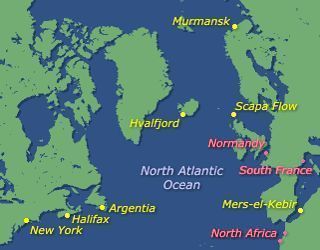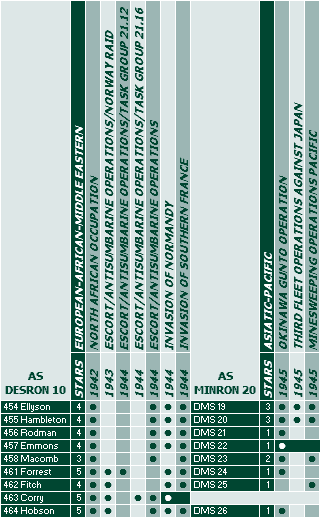
USS Ellyson, DD 454, flag

Courtesy Curious Software.
DesRon 10’s theater of operations in the North Atlantic and Mediterranean, 1942–44.
Nine ships with hull numbers 454–464 were commissioned between 28 November 1941 and 3 February 1942 (excluding hulls 459–460 assigned to Benson-class 1,620-tonners, which were commissioned later). Ellyson (DD 454), Hambleton (DD 455) and Rodman (DD 456) were built at Federal Shipbuilding & Dry Dock Corp., Kearny, New Jersey; Emmons (DD 457) and Macomb (DD 458) were the last two ships of their class launched by Bath Iron Works, Bath, Maine, collectively forming Destroyer Division 19. There were also four ships from navy yards that had previously completed 1,620-ton “flat stacks”: Forrest (DD 461) and Fitch (DD 462) from Boston and Corry (DD 463) and Hobson (DD 464) from Charleston, which together formed Destroyer Division 20. Ellyson, the first-commissioned, became DesRon 10 flagship.
Destroyer Squadron 10
World War II Operations

Though deployed on the same types of mission, ships of the two divisions did not often operate together. After shakedown, they joined the North Atlantic Patrol operating from Argentia, Newfoundland and Hvalfjord, Iceland. They supported the invasion of North Africa, escorted a convoy to Murmansk, and twice were assigned to operate with the British Home Fleet based at Scapa Flow, Hobson was temporarily assigned to the Bogue hunter-killer task group 26 February to 25 March, 1944, with which she received the Presidential Unit Citation.
In the spring of 1944, the squadron was briefly deployed to the Mediterranean Sea where, operating from Mers-el-Kébir, Algeria, DesDiv 19 led a successful three-day hunt for U-616, later called “Operation Monstrous.”
The squadron soon returned to ports on the English channel to prepare for the invasion of Normandy. On D-day, 6 June (less Emmons, which was temporarily assigned to DesRon 18), it operated off Utah Beach where Corry was hit by a shore battery and sunk.
After participating in the bombardment of Cherbourg, the eight survivors returned to the Mediterranean where, through September, they supported the invasion of South France, bombarding targets along the Côte d’Azur and the Italian Riviera.
In October, with the Atlantic and Mediterannean theaters secured, all eight ships returned to east coast navy yards where, over a period of approximately six weeks, they had their No. 4 5-inch guns replaced with gear for sweeping acoustic mines. On 15 November they were reclassified as destroyer-minesweepers (DMS 19–26) and in 1945 sent to the Pacific as the core of Mine Squadron (MinRon) 20. (continued)